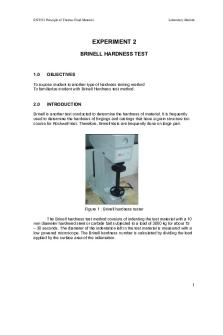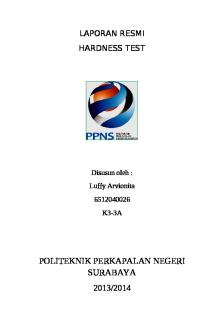E2- Brinell Hardness TEST PDF

| Title | E2- Brinell Hardness TEST |
|---|---|
| Author | King Slayer |
| Course | Diploma in programming |
| Institution | Politeknik Seberang Perai |
| Pages | 5 |
| File Size | 261.3 KB |
| File Type | |
| Total Downloads | 108 |
| Total Views | 148 |
Summary
Download E2- Brinell Hardness TEST PDF
Description
ENT153 Principle of Thermo-Fluid Material
Laboratory Module
EXPERIMENT 2 BRINELL HARDNESS TEST
1.0
OBJECTIVES
To expose student to another type of hardness testing method To familiarize student with Brinell Hardness test method.
2.0
INTRODUCTION
Brinell is another test conducted to determine the hardness of material. It is frequently used to determine the hardness of forgings and castings that have a grain structure too course for Rockwell test. Therefore, Brinell tests are frequently done on large part.
Figure 1 : Brinell hardness tester The Brinell hardness test method consists of indenting the test material with a 10 mm diameter hardened steel or carbide ball subjected to a load of 3000 kg for about 15 – 30 seconds. The diameter of the indentation left in the test material is measured with a low powered microscope. The Brinell hardness number is calculated by dividing the load applied by the surface area of the indentation.
1
ENT153 Principle of Thermo-Fluid Material
Laboratory Module
Figure 2 : Brinell hardness calculation The Brinell hardness is obtained by dividing the test force by the curved surface area of the indentation. It is calculated by using the following formula: 2 F Brinell hardness value 0.102 D D D 2 d 2
Where: F = test force, in N D = diameter of the ball, in mm d = mean diameter of the indentation, in mm. A well structured Brinell hardness number reveals the test conditions, and look like follow; “75 HBW 10/500/30” which means that a Brinell Hardness of 75 was obtained using a 10 mm diameter hardened steel with a 500 kgf load applied for a period of 30 seconds. However, it is also specified as follow; 356HBW where 356 is the calculated hardness and the W indicates that a carbide ball was used. Metals that are exposed to heat treatment like machining or welding normally become more brittle and harder. This material must be softened to relieve the stress inside it by annealing process. Carbon steel is a soft material with a specialty on certain properties. It has to be hardened to make use of it. The converting process of carbon steel into steel of useful hardness is done with different heat treatments such as quenching and tempering.
3.0
EQUIPMENT & MATERIALS 2
ENT153 Principle of Thermo-Fluid Material
3.1
Laboratory Module
Testing Machine The Brinell Hardness Testing Machine
Figure 2 : Brinell Hardness Testing Machine 3.2
Materials 1. Ferrous Metal(Stainless steel) 2. Non-ferrous Metals(aluminum and brass) The top and bottom surface of the test piece should be flat, smooth and parallel. They should also be free from oxide scale and foreign matter, such as dirt and oil
4.0
EXPERIMENTAL PROCEDURE 4.1 Set the test force on Brinell hardness tester as 3000 kgf. 4.2 Put the sample on stage and adjust the stage height until the smallest indicator meter show 2(small pointer on the red dot). 4.3 Maintain the pressing force for about 30 s (this period is known as dwell time). 4.4 Remove the indenter after the dwell time complete. 4.5 Take out the sample and measure the indent size by using the microscope provided and write down in the Table 1.
Name :
______________________________
Date : ______________
3
ENT153 Principle of Thermo-Fluid Material
Matrix No :
5.0
Laboratory Module
______________________________
DATA & RESULTS
Table 1
Show all calculation 1) Brinell Hardness No. for Mild stell
2) Brinell Hardness No. for Aluminum
3) Brinell Hardness No. for Brass
Name : Matrix No :
______________________________ ______________________________
Date : ______________
4
ENT153 Principle of Thermo-Fluid Material
Laboratory Module
6.0
DISCUSSION / EVALUATION & QUESTION
6.1
Explain the significance of your findings - First tell about the experiment objective - Explain the significance about your results and why is it of interest to you
6.2
Briefly summarize the key results of experiment - Discuss about the trends and the nature of your results
6.3.
Explain any unusual difficulties or problems which may have led to poor results - Gives 3 problems in your experiment
6.4
Offer suggestions for how the experimental procedure or design could be improved. - Give 3 suggestion how to improves your results
6.5.
Compare your experimental results with theoretical results. - Comparison about the hardness no
6.6
What do you understand about HARDNESS
6.7
Using your own word, explain the Brinell Hardness Test?
7.0
CONCLUSION - Make an intelligent conclusion of your experiment base on data and discussion - Give examples in industrial application - Is this result a kind of contribution to knowledge?
8.0
REFERENCES - Give at least 3 references
5...
Similar Free PDFs

E2- Brinell Hardness TEST
- 5 Pages

Lab 1 - Brinell Hardness Test
- 15 Pages

Brinell Hardness Test Lab #1
- 6 Pages

laporan uji bahan hardness test
- 8 Pages

E2 Ielts Listening Test
- 4 Pages

EXPERIMENT 3 HARDNESS TEST
- 8 Pages

Vickers Hardness Testing
- 9 Pages

ADA4 E2
- 7 Pages

E2 ED4 - Sommersemester
- 9 Pages

AH51 E2 Vargasglizeth-pdf
- 5 Pages

E2-8 - Homework Solutions
- 2 Pages

In-person lab water hardness
- 5 Pages

LCE Nexus E2 - ensayo
- 1 Pages

E2 - got HD
- 2 Pages
Popular Institutions
- Tinajero National High School - Annex
- Politeknik Caltex Riau
- Yokohama City University
- SGT University
- University of Al-Qadisiyah
- Divine Word College of Vigan
- Techniek College Rotterdam
- Universidade de Santiago
- Universiti Teknologi MARA Cawangan Johor Kampus Pasir Gudang
- Poltekkes Kemenkes Yogyakarta
- Baguio City National High School
- Colegio san marcos
- preparatoria uno
- Centro de Bachillerato Tecnológico Industrial y de Servicios No. 107
- Dalian Maritime University
- Quang Trung Secondary School
- Colegio Tecnológico en Informática
- Corporación Regional de Educación Superior
- Grupo CEDVA
- Dar Al Uloom University
- Centro de Estudios Preuniversitarios de la Universidad Nacional de Ingeniería
- 上智大学
- Aakash International School, Nuna Majara
- San Felipe Neri Catholic School
- Kang Chiao International School - New Taipei City
- Misamis Occidental National High School
- Institución Educativa Escuela Normal Juan Ladrilleros
- Kolehiyo ng Pantukan
- Batanes State College
- Instituto Continental
- Sekolah Menengah Kejuruan Kesehatan Kaltara (Tarakan)
- Colegio de La Inmaculada Concepcion - Cebu

